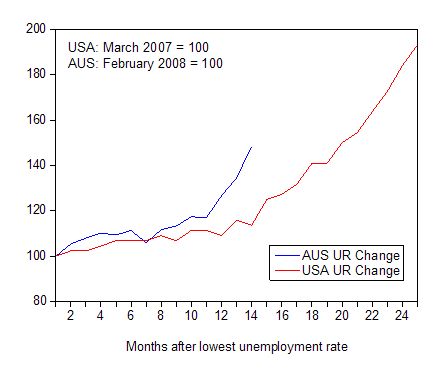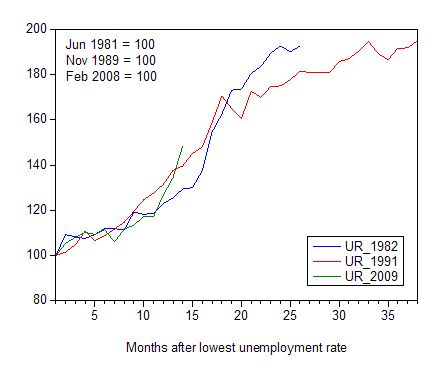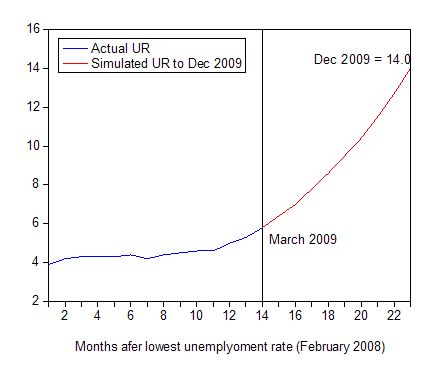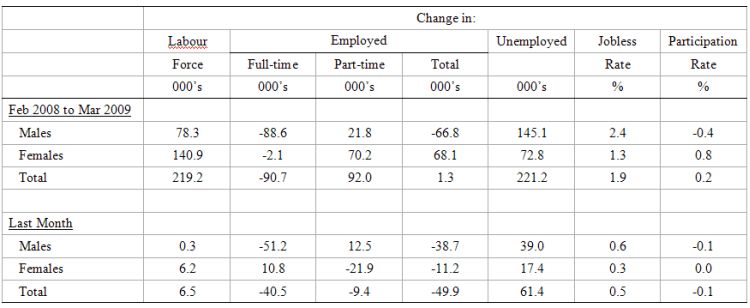The other day I was asked whether I was happy that the US President was…
Time to get real … its bad!
Despite all of us commentators clutching at straws in recent weeks looking for good messages in each new data release (for example, yesterday’s consumer sentiment data), today’s ABS Labour Force data confirms the worst. The Australian labour market is contracting fast and is now outstripping the rate at which the US labour market is deteriorating. The overall unemployment rate rose a further 0.5 per cent in March to 5.7 per cent, meaning it has risen 1.2 per cent in the first three months of this year. The dream states of Western Australia and Queensland, which had enjoyed the commodities boom bounty while the rest of us slowed, are now looking significantly sick. The speed of this decline is now faster than the early stages of the 1982 and 1991 recessions. It is time the Government ramped up its new Jobs Plan to really stop this before it escalates further.
I updated the chart I did the other day comparing the US to Australia. The unemployment rate was indexed at 100 at its lowest rate before the recession in each case (the month is detailed in the charts) and then indexed to that base for each of the months until it peaked. So you get a graphical illustration of the speed of deterioration and the length of time that the labour market deteriorated (expressed only in terms of the unemployment rate). The US labour market began deteriorating in March 2007 and so far has seen 25 months of rising unemployment rates. For the first 14 months the deterioration was moderate but has accelerated since and there is no end in sight. Australia’s labour market contraction began in February 2008 and so we are now in the 13th month of decline. For the first 11 months our rate of decline was similar to the US but in the last 2 months you can see our rate of decline is now very sharp and well above the US.

The next graph shows you the rate of deterioration (in index numbers) of the unemployment rate in the months after the lowest rate was achieved. You can clearly see how speed of the current deterioration in relation to previous recessions. At a similar point in the previous two downturns, the extent to which the unemployment rate had risen was lower (although as I showed you in a previous blog the unemployment rate started from a lower level this time).

What would happen if this rate of decline continued throughout 2009? The following chart (while not based on anything more than extrapolation of the rate of decay) shows that by December the unemployment rate would approach 14 per cent (the red line is the extrapolation!). That will not happen but it begins to put an unemployment rate of 8 per cent or higher into more perspective. It also suggests that the Federal government’s forecast of 7 per cent by mid-2010, which was used to base their $42 billion expansion package on, will be far too optimistic.

What has been happening with the components of the labour force data? The following table reconciles the movements. I computed the changes in the labour force aggregates (either in thousands or percentage points – as shown) over the period of decline to date (February 2008 to March 2009) as well as the last month. This allows us to tell an interesting narrative about what is happening.

Over the course of the downturn the big losers are so far males (having lost 66.8 thousand jobs) while females have actually gained 68.1 thousand jobs. But you start to see the familiar pattern when you look at the full-time and part-time changes. Full-time employment has fallen by 90.7 thousand jobs and has been replaced by a similar increase in part-time employment. Most of the full-time losses are being borne by males. So the economy has been holding total employment largely static but rapidly lowering the quality of the jobs available. It will get worse from here if past experience is anything to go by as even the part-time jobs start being shed in absolute terms.
Over the same period (February 2008 to March 2009) male unemployment has risen by 145,000 while female unemployment has risen by 72.8 thousand with 221.2 thousand being added to the total unemployment pool. As at March 2009, there were 651 thousand workers overall classified as being unemployed. If you add that to the underemployment which must now be approaching 750 thousand you see that total labour underutilisation (measured in persons not hours) is getting up to nearly 13 per cent of the labour force which shows you how bad things are getting.
Typically participation rates fall during a downturn as workers give up looking for the jobs that are not there. These workers become what we call the hidden unemployed. While participation rates have marginally increased since February 2008, this is all down to females (rising 0.8 percentage points) while males fell by 0.4 percentage points. So males are starting to drop out of the labour force as their employment prospects wane quite sharply. If you look at the changes in the last month, participation is now falling overall which signals that the deterioration is accelerating.
There has been a lot of speculation about the participation rate. Some commentators have suggested that the wealth losses that have occurred as a consequence of the GFC have forced people who would otherwise have retired upon losing their jobs to remain in the labour force. Others have said that the so-called “added worker” effect is outweighing the “discouraged worker” effect. There might be some truth to all that speculation. But it is starting to look to me that the discouraged worker effect is alive. Male participation rates have been falling as they have been losing jobs over the contraction. And, in the last month, the participation of females has flattened as they begin to experience net job losses themselves. I think we are seeing a typical pattern now.
The other observation worth noting is that a substantial part of the deterioration since February 2008 has actually occurred in the last two months with the last month February-March being particularly severe. 50 thousand jobs went in the last month (40.5 thousand full-time and 9.4 thousand part-time). So as things worsen we are starting to see the absolute falls in employment (negative employment growth). Up until that point the firms had been replacing full-time work with part-time hours (and jobs) but in the last month even part-time jobs have been shed in net terms.
Conclusion
What this all suggests is that the Federal government has to quickly rethink it strategy. Fortunately, it has now conceded – by dint of its Jobs Plan announced last weekend – that direct job creation is required. As I said earlier this week, that gets us over the hurdle that has been put up by neo-liberals for years that there is no role for demand-side measures (direct public job creation). Now we just have to make sure the initiative is sufficiently scaled to meet the problem that is now emerging.
I have the leaked text of a statement that sources tell me the Prime Minister will be making to the Australian people this evening. I might have even written it. I also wouldn’t mind if he uses it as it is. I am sure he will source it unlike some of the recent examples of plagiarism by senior (conservative) MPs. Anyway, here is the rumoured text for tonight’s announcement.
The Prime Minister:
The Federal government initially thought it would solve this problem by handing out cash willy nilly to New Zealanders and even recently deceased people. We also thought that building even better sporting facilities at the most exclusive schools in Australia would help. And as you know, we are injecting billions into the old Job Network because we want to make it better. I realise there are people out there … such as that Professor from Newcastle who has been relentless in telling us that it is a crock and “good money is chasing bad”. But we are trying you know.
Anyway, with today’s shocking deterioration in the Australian labour market I have to admit that I am human, and have made mistakes. Those previous stimulus packages were an example of that human frailty. I am learning from these mistakes and last weekend I announced a $650 million Jobs Plan which will directly create jobs in areas of severe disadvantage.
I have to tell you though that this was a such a sh*t amount to outlay given it might only support 40,000 jobs if that. This is especially so when you consider that that research centre from Newcastle … the drink … CofFEE … has done three years of elaborate research and has estimated that we can create 560,000 low-skill jobs at minimum pay for $8.3 billion per annum and start winding back some of the unmet community need and environmental degradation that those terrible budget surpluses of the past 11 years created.
So now I want to announce to the Australian people that the Federal Government will offer a job at the federal minimum wage to anyone who wants to work and currently cannot find it. All you have to do is turn up tomorrow morning at your local depot to start work. If we haven’t any work ready for you to do immediately, we will have soon! In the meantime your pay starts tomorrow. Ring XXXXXXX for details or look in tomorrow’s newspapers. We are calling this initiative the Job Guarantee and believe it will provide a safety net for those who lose their jobs.
I expect the announcement to be made around 19:30 tonight!
You fair dinkum about the announcement Bill?
I will be taking my family to the local easter festival so I will miss it.
I think you will have a better time at the easter festival than hanging around the radio/TV waiting for the PM to say something as sensible as the “leaked” statement.